
UTAH AIRCRAFT MYSTERY
Report #185
May 8, 2010
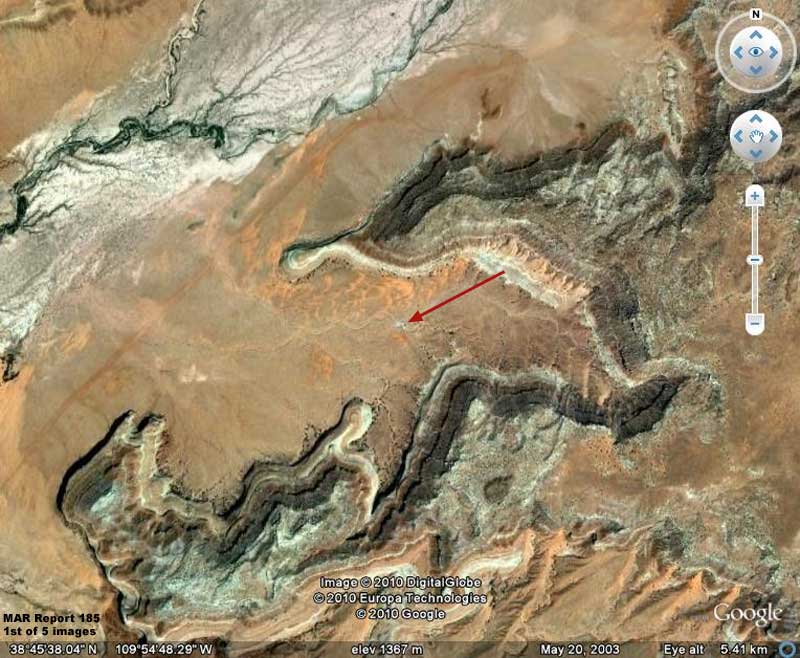
The above 1st image provides a context
view of the general area within which this evidence resides. More specifically
the red arrow in the above image points to the spot where the aircraft evidence
is located while the long shank of the arrow demonstrates the northeast direction
from which the aircraft came from at the time it was caught in flight heading
southwest in this Google Earth image. This evidence came to my attention via
Azzabuv in the UK.
Note that this location is within what is essentially a Utah open ended box
canyon. The darker material is the high ground and the orange to tan color
material is the canyon floor lower ground. This is a dry waste and is in fact
in the fringe area of Canyonlands National Park in Utah similar to the Grand
Canyon in Arizona further south but not nearly as deeply eroded. This particular
canyon is not part of the Canyonlands tourist attraction and shows almost
no signs of use or visitation which is likely why someone operating the aircraft
in question here probably chose this area as part of their flight path.
The aircraft almost certainly came from the northeast flying low over the
back of the dark high ground there and then immediately dove down into this
crayon flying low over its terrain. This was likely to avoid appearing as
a signature on radar and therefore was likely a clandestine flight of some
kind and perhaps an experimental flight for this equipment.
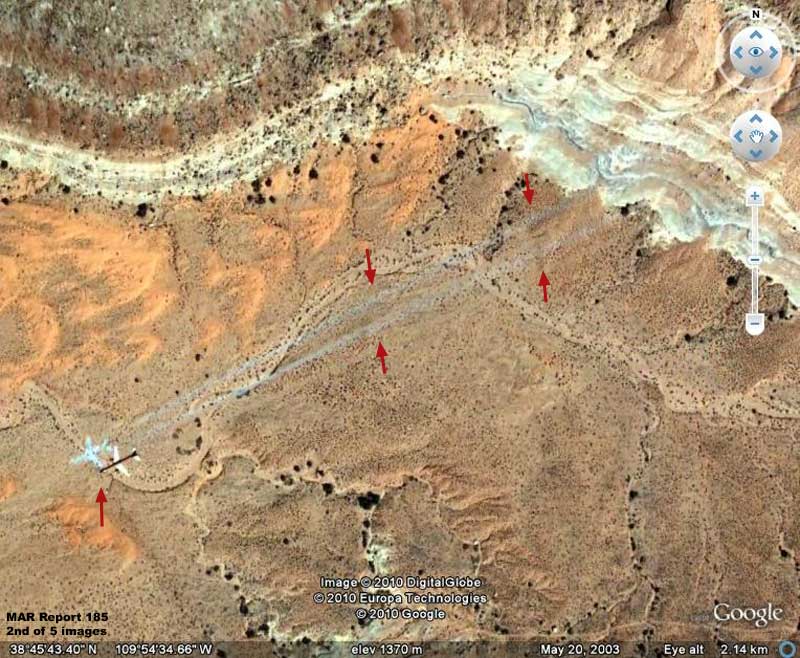
The above 2nd image demonstrates a distant
view of the aircraft and its flight path as demonstrated by the engine exhaust
trails. Note that the aircraft shadow on the ground is a strange uniform light
blue color as are the two fairly prominent twin engine exhaust trails stretching
out behind and to our right of the aircraft as pointed out with the red arrows
leading all the way back to the light colored slope down into the canyon.
Note also how close the aircraft ground shadow is to the aircraft indicating
how close to the ground the in flight aircraft is.
Note also that there is a very faint but very straight lighter color line
on this side of and paralleling to the light blue contrails. This is likely
one of the aircraft's true engine exhaust heat trails in the air causing a
faint visual distortion when looking through it to the ground below since
the aircraft is flying so low. This latter evidence can only be adequately
seen in this distant view and why I have provided such a view.
It is logical that the aircraft, if it is powered by much of anything conventional,
flying low over the highlands in the upper right area of the image would have
to boost power a bit after it dropped down into the shallow canyon flying
low and level over that terrain. That would account for the contrail extending
back to light color terrain in the upper right of the image representing the
slope down into canyon but not further back into the highlands.
Now this is a very dry very remote untrafficked box canyon and the aircraft
is flying very low over the terrain. So, with a boost in power from the engines
leveling out over this canyon floor terrain, it is possible that the very
faint straight engine exhaust trail seen in the 2nd image could be the result
of dust stirred up from the canyon floor not only by the engines but the wake
of the body of the aircraft passing over the terrain so low.
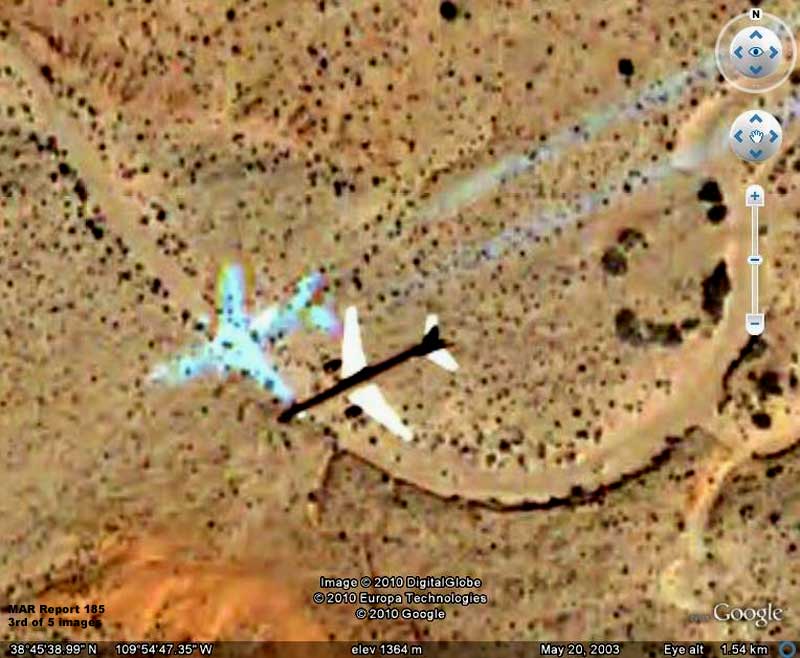
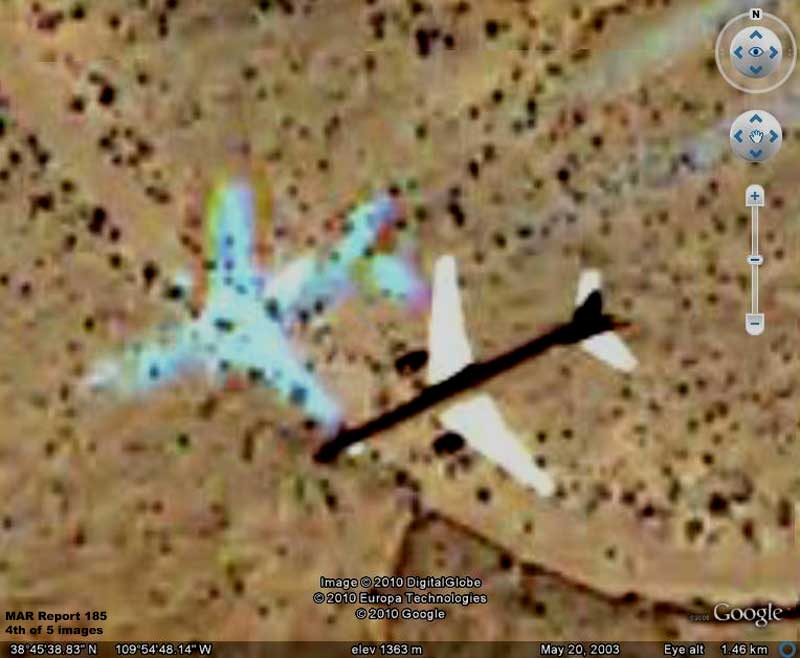
The above 3rd and 4th images provide a
much closer and clearer view of the aircraft itself, the strange light blue
shadows it generates on the ground, the long dark thin stick like body of
the aircraft, the dark two large engines hanging under the main wings, and
the terrain it is passing over. Note that these closer images confirm that
the twin light blue exhaust trails are in line with and associated with the
aircraft shadow and not the aircraft itself confirming that the light blue
exhaust trails too are shadows.
The light blue shadows are obviously strange, dramatic and suggests some unknown
(to us) technology being employed here. This is why I am reporting on this
aircraft. Obviously, something very unconventional is going on here and I
thought you might be interested in it.
With that thought in mind, please examine closer. Note
that the ground as seen between the rear of the main large side wings and
the front of the tail smaller wings and that it is considerably visually distorted.
Note that this distortion appears to be associated with these wings and perhaps
the main body of the aircraft rather than be limited to streaming heat signatures
generated by the engine exhausts.
The long thin dark body of the aircraft suggests possibly not an onboard manned
aircraft at all but an experimental large drone testing platform for instruments,
remote controlled flight, and perhaps a new power drive systems and/or cloaking
technology. That light blue instead of dark black aircraft shadow and even
the exhaust trail shadow left on the ground suggests
a great deal in this regard that some unconventional power source is being
actively used here despite the otherwise fairly conventional cosmetic looks
of the aircraft itself.
Also, please note that the aircraft could not be sitting disabled on the ground.
If that was all there was to this and this was such a conventional scene,
the aircraft would be casting a dark shadow to some degree on the ground under
it but isn't. Note also that the aircraft is spanning a large dry wash water
drain erosion system, which can be expected to be rough, but is unaffected
by it.
I would seem that this aircraft is definitely in flight very low over this
canyon floor terrain at the moment this image was taken. The observer is just
going to have to come to terms with the fact that this strange aircraft is
leaving some kind of very strange funky looking light blue shadow and/or imprint
on the canyon floor it is passing over. Perhaps someone is testing a very
high atmosphere aircraft here that has a unconventional power supply capable
of operating in space where such visual effects would be different?
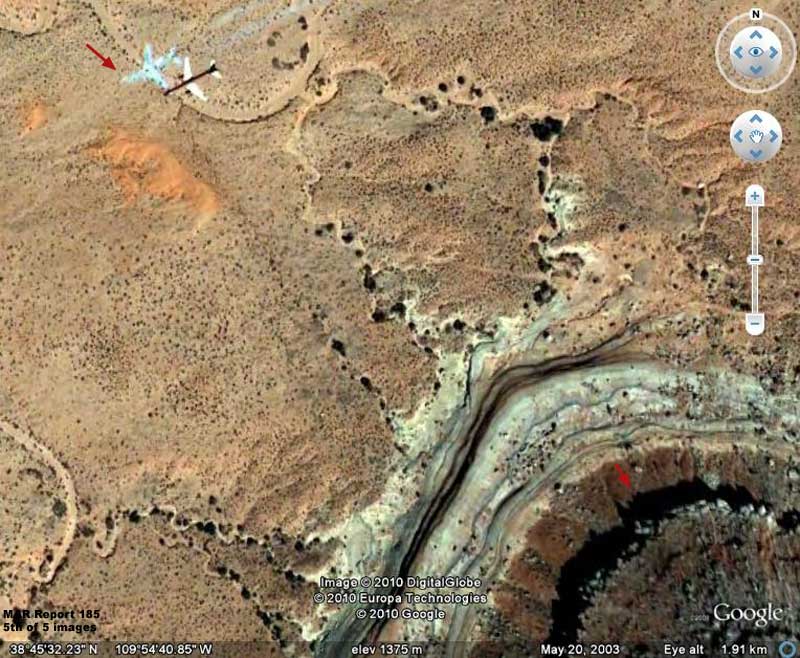
The above 5th image is included here to
demonstrate sun angle and that the light blue evidence on the ground at the
aircraft is consistent with other sun angle shadow demonstrated in this image.
For example, note the elevated cliff shadow pointed out with the red arrow
in the above image lower right field versus the aircraft and its shadow located
in the upper left and also pointed out with a red arrow. Enough said.
Unless there are some very powerful experimental engines here associated with
this aircraft and not just those hanging under its main wings protruding forward
out from under the wings, those long wings tell us fairly conventional atmospheric
flight based on speed and lift. However, its long uniform tube like slender
light weight looking but large body could mean very high atmospheric flight
to the point of entering into space.
One thing I think we can safely say here is that this is no UFO belonging
to someone else but some sort of experimental high tech mostly conventional
aircraft belonging to the USA serving as a test bed for technology not immediately
apparent except for the strange blue shadows behavior in the terrain. In any
case, thought you might be interested in observing this.
, Investigator
![]()